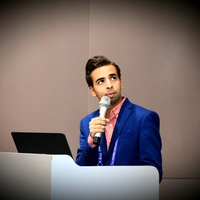Mouataz T. Mostafa
Arish University, Geology, Faculty Member
- The leader of the Egyptian chapter at the International Medical Geology Associationedit
Wadi Abu Subeira area contains many farms and houses and is one of the promising areas for iron mining. Therefore, 21 surface soil samples were collected and investigated for toxic heavy metals (Pb, Cr, Ni, Cu, Zn, Co, and As) using... more
Wadi Abu Subeira area contains many farms and houses and is one of the promising areas for iron mining. Therefore, 21 surface soil samples were collected and investigated for toxic heavy metals (Pb, Cr, Ni, Cu, Zn, Co, and As) using inductively coupled plasma (ICP) to establish a geochemical baseline for these metals during pre-mining conditions. To decipher the sources of these metals and their interrelationships, multivariate statistical analysis was applied, while to evaluate the degree of pollution and potential environmental risks the environmental indices were used. Abundances of Pb, Cr, Ni, Cu, Zn, Co, and As fluctuated from 17.72 to 0.06, 47.12 to 10.86, 47.88 to 9.25, 45.04 to 6.23, 51.93 to 17.82, 10.55 to 1.24, and 7.04 to 1.66 mg/kg, respectively, displaying a declining trend of Zn > Cr > Ni > Cu > As > Co > Pb. Additionally, the mean concentrations of all studied metals were found to be significantly lower than the selected international reference stan...
Research Interests:
ased on the contents of heavy metals (Co, Cr, Cu, Fe, Mo, Mn, Pb, and Zn) in 22 road dust samples, the urban environmental quality of Wadi El-Qamar area was evaluated. It is a residential area suffering from unplanned industrial... more
ased on the contents of heavy metals (Co, Cr, Cu, Fe, Mo, Mn, Pb, and Zn) in 22 road dust samples, the urban environmental quality of Wadi El-Qamar area was evaluated. It is a residential area suffering from unplanned industrial activities, overpopulation, and uncontrolled urbanization. Heavy metal sources and geochemical associations were deciphered using a multivariate statistical approach, while the contamination degree and ecological risks were identified using various pollution indices. Moreover, the human health risks (carcinogenic and non-carcinogenic) for residents were estimated via different exposure pathways. The mean abundances of elements were as follows: Fe > Mn > Zn > Cr > Cu > Pb > Mo > Co, while the individual contamination grades decreased in the following order: Mo > Cu > Zn > Pb > Cr > Fe > Mn > Co, according to the geoaccumulation index (I geo) and the contamination factor (CF) average values. The high correlation between Zn and Cu (r = 0.92) reflected their common origin (traffic-related emissions). Notably, only Cu showed individual ecological risk; meanwhile, the overall ecological risk index (RI) classified the study area as having low ecological risk (RI < 150), with an average of 75.20. The health risk assessment indicated the absence of adverse non-carcinogenic risks and the presence of unacceptable carcinogenic risks posed by Cr and Pb. Ultimately, heavy-duty vehicular emissions (e.g., tire and brake wear) and industrial emissions from cement and refining companies are likely the main contributors to heavy metal loadings in the study area. The results of this research will be useful in developing strategies for pollution control and management and can be utilized for comparison in future studies.
Research Interests:
Caves are commonly used for the purposes of geological conservation and tourism, but such experience is very limited in desert areas of northeastern Africa. The Sannur Cave discovered near Beni Suef in Egypt a few decades ago has been... more
Caves are commonly used for the purposes of geological conservation and tourism, but such experience is very limited in desert areas of northeastern Africa. The Sannur Cave discovered near Beni Suef in Egypt a few decades ago has been investigated in order to judge about its importance as geological heritage. It is established that the study territory contains three principal elements that can be attributed to geological heritage. These are the Sannur Cave itself, two quarries of the so-called Egyptian alabaster (recrystallized Eocene limestones used for ornamental stones and sculptures), and the geological landscape in the vicinities of the cave with some outcrops of Cenozoic rocks representing various facies and bearing numerous fossils. Two dominant geological heritage types of the study territory are geomorphological and sedimentary types, which represent globally and nationally unique phenomena. The Sannur Cave and the relevant features can be used for the purposes of geological conservation, research, education, and tourism, which make it an important natural resource. Geopark creation can help in efficient exploitation of the latter.
